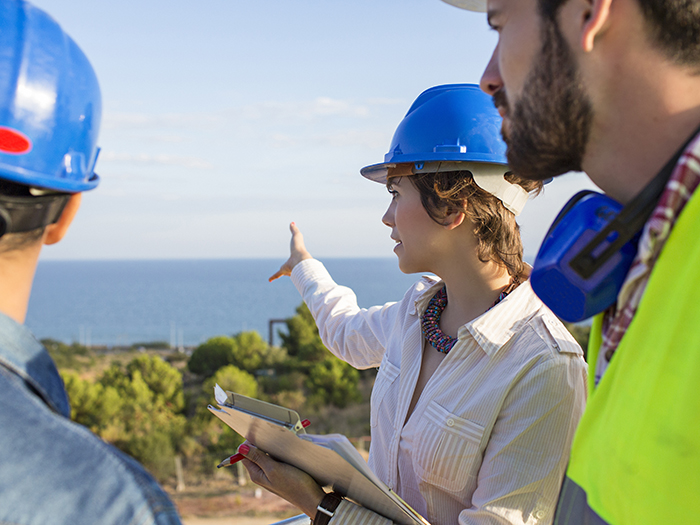Construction Surety Bonds Are More Relevant Than Ever. You Can Thank Inflation, Supply Chain Challenges and Labor Shortages

Whether it’s a bridge or a public school, every public construction project you pass required a surety bond at one point.
The U.S. government requires every contractor it works with to purchase a surety bond as a way to ensure their work will be completed in a timely and cost-effective manner. Contractors purchase a bond and, in turn, the surety agrees to meet the contractors’ obligations if they’re unable complete the project — even if that means finding another contractor or compensating the project owner for the costs they’ve incurred.
“Schools and highways don’t get built without surety bonds in place,” said Mike Heidrick, vice president, head of construction surety at The Hartford.
“Those bridges that you go across in Boston or New York? All of those required a bond at one time. All the highways that you’re driving on required a bond. All public construction — from school parks to ball fields to high schools to elementary schools — required bonds.”
Bonds have played an essential role in public construction projects for centuries, but today, forces like inflation, supply chain delays, labor shortages and the drive to build high-performing renewable energy projects makes this financial guarantor more critical than ever.
Surety Bond History: From the 19th Century to Today
Construction surety bonds became widely used in the U.S. after the Civil War. During the Reconstruction era, the federal government hired a number of contractors who failed to complete the projects they’d been hired to do.
“There were lots of contractors that came and did a lot of work for the federal government, and what happened is these contractors got their first payments and then they disappeared. Today we have the Miller Act for federal work, and states have Little Miller Acts, that require bonding of publicly funded work,” Heidrick said.
So the government stepped in and required contractors to buy bonds equivalent to the cost of the project as a means of guaranteeing their work. That way, if the contractor decided to walk away before the work was completed, tax dollars were protected.
Today, surety bonds help guarantee everything from the construction of new roads and public buildings to renewable energy projects like solar panel fields and wind turbines.
Investments in the construction and real estate industries as a result of the Inflation Reduction Act will likely further the need for bonds as new public projects get underway. That’s on top of the nearly $550 billion of investment in new infrastructure projects expected over the next decade, according to Bipartisan Infrastructure Law estimates.
In addition to the public works requirement, private investors and developers often seek out bonded contractors to protect their projects.
Inflation, Supply Chain Issues and Labor Shortages
From building new manufacturing sites to provide companies with relief from semiconductor shortages to undertaking renewable energy projects, federal and state governments in the U.S. are creating a number of opportunities for contractors that will need to be bonded.
Moreover, several economic factors make today’s construction projects more complex, increasing the need for projects to be bonded. Worsening supply chain delays, inflation and labor shortages are all influencing how much a construction project costs and how long it lasts.
Let’s start with inflation. Building materials costs rose 20% between January 2021 and January 2022, an Associated General Contractors of America analysis of government data found. Costs of steel, lumber, roofing products and insulation were all affected. Though NBC News has reported that building materials costs are beginning to come down, many developers are still struggling with materials pricing concerns.
Beyond inflation, much-needed investments in infrastructure could easily be delayed due to supply chain bottlenecks, adding costs to a project as timelines swell. Even if a builder has all the materials they need, they may struggle to find workers. The industry currently faces a shortage of almost 430,000 workers, Associated Builders and Contractors reported last year. That shortage is only expected to grow, as 40% of construction workers in the U.S. will likely retire over the next 10 years, per 2022 reporting from Forbes.
“Today a majority of contractors are experiencing a shortage of labor,” Heidrick said.
“To the owner of the project, the surety bond provides peace of mind that if the contractor fails and doesn’t complete the project, they’ll have someone else who will.”
Government bonding requirements can help the public have faith that the contractors working on public projects will be able to rise above these uncertain economic times. Unfortunately for private projects, Heidrick says, some investors do away with surety bond requirements in an attempt to lessen project costs. That strategy can be challenging if a contractor needs to leave a project due to supply chain struggles or labor shortages.
“When you have tough economic times, it can really affect the health and well-being of a contractor,” Heidrick said. “You want to make sure, as a project owner, that you have a bond on it.”
Risk Management to the Rescue
When underwriting a surety bond, Heidrick and his team assess a contractor’s financial health as well as the risk management strategies they have in place to detect whether supply chain delays or staffing shortages could affect a project.
“Good contractors are good problem-solvers,” he said. “Every construction job is unique unto itself. Every one of these jobs has problems, and every one of these contractors has great systems in place to identify problems early so that they can go in there and correct those problems.”
As part of the process, bonding partners will also help contractors consider what risks they may be assuming with a particular contract for a project. If a renewable energy project contract wants a contractor to guarantee a wind turbine’s or a solar panel’s efficacy, rather than just the building process, a builder may not be comfortable assuming that long-term risk.
When a bonding partner reviews contracts to determine whether they want to underwrite a project, they can alert contractors to this kind of language, helping them stay abreast of new exposures.
“We’re in the business of helping people keep their promises,” Heidrick said. “We need to understand every aspect of the contract. We don’t want our contractors taking an ownership risk where they don’t have to.” &










